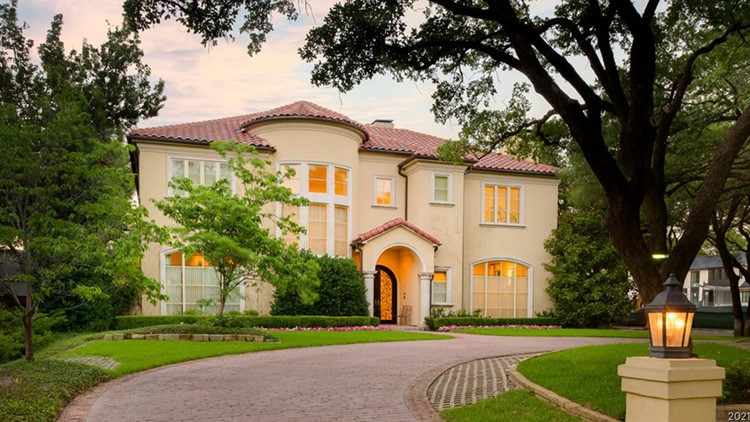DALLAS — Read this story and more North Texas business news from our partners at the Dallas Business Journal
The Highland Park ZIP code 75205 is the hottest housing market in Dallas-Fort Worth, followed by the Preston Hollow neighborhood in northwest Dallas and Bluffview, just east of Dallas Love Field.
That's according to a new analysis by The Business Journals of home price data from Zillow Group Inc. that compared markets by home price momentum at short- and long-term intervals. The analysis focused on ZIP codes with median home values of at least $250,000 and a population of at least 5,000.
The markets were ranked using a formula that emphasizes six-month and one-year housing pricing changes, with five-year and one-month changes included but underweighted. The Dallas Business Journal breakdown of the national data zooms in on Dallas, Tarrant, Collin, Denton and Rockwall counties.
Highland Park's 75205 ZIP code, with a median home value of $1,761,405 as of June 30, topped the rankings in DFW. The median home value in the area is up 2% from a year ago, when it stood at $1,722,283, and up 3% from six months ago, when it was $1,716,661. The median value in Highland Park has soared 59% since June 30, 2018, when it stood at $1,109,038.
The 75229 ZIP code in northwest Dallas is the second-hottest housing market in DFW. The ZIP code is one of several in Preston Hollow, the home of former U.S. President George W. Bush and other notable residents.
Preston Hollow's 75229 ZIP code, with a median home value of $651,800, has seen values grow by 3% in the past year and 4% in the last six months. The median value in the 75229 postal zone has risen 49% in the past five years, when it stood at $437,908.
The 75209 ZIP code, east of Dallas Love Field and west of the Dallas North Tollway, is the third-hottest housing area in DFW. The area, called Bluffview, has a median home value of $861,774, which is up 2% from a year ago and 4% from six months ago. The median home value in 75209 has climbed 49% since June 30, 2018, when it stood at $577,262.
The 75214 ZIP code just west of White Rock Lake in northeast Dallas and the 75225 postal zone in University Park round out the five hottest housing markets in DFW.
Further down the list are more neighborhoods in Dallas, plus Sunnyvale in Dallas County, Justin in Denton County, Southlake in Tarrant County, and two ZIP codes in Rockwall.
ZIP codes in Irving, Roanoke, Frisco, Colleyville, Argyle, Farmers Branch and Grapevine also ranked in the top 20 hottest housing markets in Dallas-Fort Worth.
ZIP codes in Fort Worth, Euless, Mansfield, Highland Village, Arlington, Richardson, The Colony, Coppell and Prosper ranked a little further down the list.
Across DFW, home prices dropped 2.9% in April compared to a year ago, according to the most recent S&P CoreLogic Case-Shiller home price index. In March, DFW prices saw their first year-over-year decline in the index in over a decade — since February 2012.
However, as The Business Journals analysis of Zillow data shows, home prices continue to rise in many parts of DFW even as they fall in others.
Nationally, the rankings of the housing ZIP codes for home price momentum were dominated by vacation and second-home markets, with ZIP code 33480 in Palm Beach, Florida; and ZIP code 81657 in Vail, Colorado; leading the way.
Housing market outlook for the remainder of 2023
Nationally, tight supply continues to weigh heavily on the housing market's trajectory.
According to Zillow Group Inc. (Nasdaq: ZG), total active inventory in June was down 10.4% from a year prior and 44.9% below June 2019 levels. That's especially significant because the summer months are historically peak buying and selling months, underscoring the abnormal state of the current housing market.
It's possible people’s attitudes or expectations about home prices have also played into an owner's willingness to list their home, said Jeff Tucker, a senior economist at Zillow. When the market began to cool last summer and fall, some owners may have perceived it as a bad time to put their homes on the market, Tucker said — especially if they paid at or near the top of the market during the recent run-up in home prices.
"Homeowners stopped selling, to a surprising degree," Tucker said. "That flow of new listings has been gradually starving the market of that new supply."
Most housing economists agree that mortgage-rate movement is the key to unlocking not only more buyer demand, but also potentially new supply, as that could motivate existing owners to list their homes if they've been waiting to buy a bigger home or move.
Economists aren't predicting a precipitous drop in mortgage rates, though, especially in the near term. Additionally, any persistent drop in mortgage rates is likely to compel more buyers to enter (or re-enter) the market than sellers to list their homes.
"My hunch is that (mortgage rates) coming down will have as much of a tailwind to demand as it would to supply and, therefore, with falling interest rates, would still on balance crank up the temperature in the industry and boost demand (more) than supply," Tucker said.



